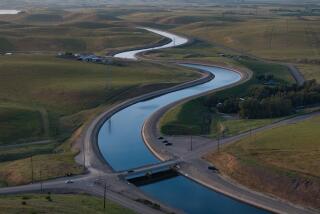Holding Off Troubled Waters : Officials Are Confident They Can Keep County Supplied : STANLEY E. SPRAGUE
- Share via
It can come as a shock to visitors and natives alike, but despite its abundant greenery, Southern California is a semi-arid desert, largely dependent on imported water for its phenomenal economic growth. Today, even as a statewide drought ends its second year and the Southland’s allocation from the Colorado River shrinks, the population continues to soar and business development proceeds at a blistering pace.
Southern California, thanks to the efforts of aggressive water agencies that have reached far afield to find supplies, has been able to create a massive and healthy economy by importing water. Currently, Southern California brings in 66% of the water needed to support it, and this dependence on imported water will continue to rise, water experts say.
Times staff writer John O’Dell conducted separate interviews with three of the top water officials in the Southland to explore the relationship between the water supply and continued development in the county. Those interviewed were Timothy Quinn, chief economist for the Metropolitan Water District of Southern California, which is responsible for finding and importing water; Stanley E. Sprague, general manager of the Municipal Water District of Orange County, which sells that imported water locally--mainly in south Orange County, which does not have a domestic water local supply to draw on, and William Mills, general manager of the Orange County Water District, which manages the huge underground water basin that provides much of the north and central parts of the county with their water.
Q. Is your attitude the same as Metropolitan’s and the OCWD’s, that there is no limit to the amount of development and population density you can serve?
A. There really is plenty of water. The only problems are problems of either getting it here or moving the people to where the water is. That gets into discussions of land use. And you can’t use water to control land use in Orange County because when you tell a developer that he can’t build in the south county because there might not be enough water, he just goes off to Riverside, and that places the same demand on our imported water. A different agency has to worry about it, but we all get our water from the same sources. So, our attitude in the water community is that yes, we will supply. The thing that maybe we don’t say enough is that we certainly hope the other parties that have to make land-use decisions are making the right decisions.
Q. By that you mean. . . ?
A. The problem is that if you look at the water code, the water agencies have a responsibility to supply water. We have no jurisdiction over land use. I’m not sure if the dog is wagging the tail or the tail is wagging the dog. The county and the city governments have to come to grips with how they want certain areas to develop. And then we will deliver the water.
Q. From your perspective, what does the future for water and development in south Orange County look like?
A. Basically, we are in a good position because of our advance planning. We get water from two watersheds, the Colorado River and Northern California. Both were impacted by drought, but the Colorado system was well thought out and has a large storage base. It is the state water system that delivers water from the north that is poorly designed and is affected more dramatically. Our biggest problem right now is public perception. Orange County doesn’t look like a semi-arid desert, so it is hard to get the public concerned. But no matter what the drought situation is, growth will continue.
Q. And how do you find the water to cope with the growth?
A Well, it used to be just a problem of hard engineering. You designed a good system to bring the water from the Colorado River and then you built it. But now we are out of the days of big projects like that because of all sorts of financial and political and environmental considerations. We no longer talk about hard engineering but about three- and four-party negotiations, court decisions and the like. To try to resolve this, Metropolitan has a laundry list of projects a mile long. We are looking for Metropolitan to continue its efforts to obtain more water and for Orange County Water District to continue providing good management of the ground-water basin. With those two efforts, we get a dependable supply of water. And because we have no local water resources to deal with in the areas we serve, we are looking to attitude modifications, to getting people to think conservation.
Q. And that involves what? Just voluntary actions?
A One area we are interested in is coming up with model ordinances for our retail water agencies to use to encourage conservation or even to mandate it in some cases where mandatory conservation isn’t hurting people. An example already in place statewide is the requirement that water-conserving toilets be used in new homes and offices in many areas. One that we might consider would be a requirement for low-consumptive landscaping or low-flow irrigation systems in new developments.
Q. But with the south county entirely dependent on imported water, don’t you also have to consider harder choices, like water rationing?
A. Rationing would occur when Metropolitan can’t give us the water that we need. If that happens, we will have to work with OCWD to develop a rationing plan. We have talked about the situation, but we don’t really know how to ration until we see what Metro would do.
More to Read
Sign up for Essential California
The most important California stories and recommendations in your inbox every morning.
You may occasionally receive promotional content from the Los Angeles Times.













